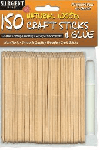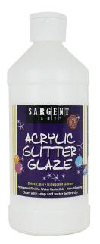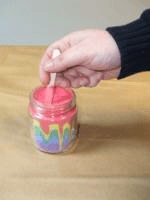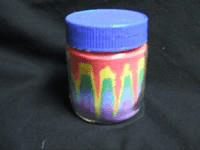Many cultures have created art with colored sand. Native American Navajo Indians used colored sand designs in ceremonies to restore health and harmony in their lives. After the ceremonies, the designs were swept away. They mixed sand with natural materials (flowers, charcoal, bark, roots) to make their colors. Navajo children learned this art by watching their elders. Today the Navajo Indians also make sand paintings that are permanent works of art. They are often sold to tourists.
Goal (Terminal Objective):
Students will mix color pigments into sand and layer the colored sands into jars to create colorful works of art. These art works will show students’ understanding of Navajo sand art design.
Objective:
Students will understand how art forms become historical records of cultures. They will learn about the Navajo Indians, where and how they lived, and how they created art that is distinctive to their culture. Students will use colored sands to create art in glass jars.
National Standards:
Visual Arts Grades K-4 Content Standard 1: Understanding and applying media, techniques, and processes
Visual Arts Grades K-4 Content Standard 3: Choosing and evaluating a range of subject matter, symbols, and ideas
Visual Arts Grades K-4 Content Standard 4: Understanding the visual art in relation to history and culture
Visual Arts Grades K-4 Content Standard 5: Reflecting upon and assessing the characteristics and merits of their work and the work of others
Purpose:
Students will focus on creating beautiful designs with sand. They will experience the process of layering colored sands in jars and blending the colors into original works of art inspired by the art of the Navajo Indians.
New Vocabulary:
Native American, Navajo Indians, sand art, sculpture
Materials:

#35-1436 Natural craftsticks

#22-8811 Acrylic Glitter Glaze
small glass jars, sand (or salt), paper cups, spoons, powder paints, 1/3 cup measuring cups
Time:
1 lesson (60 minutes)
Introduction and Motivation (Set):
- Teacher introduces students to the sand art paintings of the Navajo Indians. A brief history is given about the original purpose of this art. How did the Navajos make colors for their art works? Students look at a variety of sand art paintings.
- Do you think that making sand art paintings is difficult or easy?
- Do you know that the Navajo Indians live in New Mexico, Arizona, and southern Utah? Students find these states on a map. What do you think your life would be like if you were a Navajo child?
- Teacher introduces new vocabulary.
Instruction:
Lesson:1
Teacher demonstrates pouring 1/3 cup of sand into paper cups. Teacher adds spoonfuls of colored tempera powders into the cups and mixes them with plastic spoons. Teacher demonstrates spooning layers of sand colors into a glass container. Using a craft stick, teacher carefully mixes the sand layers to create an original design inside the glass jar.The glass jar is covered tightly. The lid of the jar is glazed with acrylic glitter glaze. Students return to their work areas and complete their glass jar sand art works.


Activities:
(1) Guided Practice:
- Students learn about creating art from sand and powdered tempera paints. They are introduced to the sand art paintings of the Navajo Indians. Students watch teacher demonstration and see teacher exemplars.
- Students use measuring cups to measure sand. They add spoonfuls of colored powdered tempera paints and mix with plastic spoons. Individual design choices are made when spooning the colored sand into the jars and mixing the colors.
(2) Independent Practice and Check for Understanding:
- Teacher circulates through the room during student work time, answering questions and offering support as needed.
- Teacher notes students’ understanding of directions and reviews with the class if necessary.
(3) Closure:
- Students show their glass jar sand art designs to classmates. Teacher displays the glass jars for everyone to view.
- Students discuss the importance of respect for individuality.
Evaluation:
During Lesson 1 teacher and students create an assessment rubric. Artworks are evaluated on the following criteria: understanding of sand art, originality, and craftsmanship.
Understanding of sand art = 4 points (The student has successfully mixed the sand with the powdered tempera paint to achieve a colored sand.)
Originality = 4 points (The student has layered the colored sands and used a craft stick to create a unique design in the jar.)
Craftsmanship = 4 points (The student worked carefully and neatly with materials and tools.)
Extension:
Students may further research the Navajo Indians, seeking out other arts (weaving, jewelry) of this culture. Students will present this information to the class.
http://navajo-arts.com/navajo-indian-tribe.html
Resources:
http://www.wisegeek.com/what-is-sand-art.htm
http://en.wikipedia.org/wiki/Sandpainting
http://www.navajosandpainting.net/
http://www.usatipps.de/Reiseziele/50_Bundesstaaten/Hoher_Westen/Colorado/Denver/ha uptteil_denver_art_museum_-_navajo_san.html
http://www.americana.net/sandpaintings_article.html
Art Consultant



